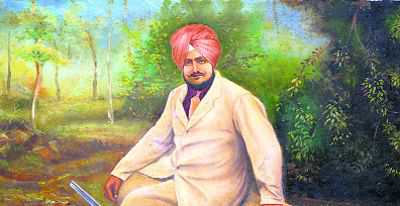Maharaja Bhupinder Singh’s sporting legacy
Randhir Singh Patiala
Olympian & Sports Administrator
Shubhranshu Singh
Corporate Strategist & Columnist
As the Maharaja Bhupinder Singh Sports and Science University gets ready to groom its first batch of sporting talent, the spotlight is on a rare and little-known facet of the multifarious persona of the former Maharaja of Patiala. At a time when the Indian landscape was dotted with the usual exciting stories of its many maharajas, Bhupinder Singh rose many notches above his peers and contemporaries with his remarkable contribution to the promotion of sports in the country.
Looking back, one can see why Maharaja Bhupinder Singh’s name has become almost synonymous with sports, especially cricket. Very few people know, even in the sports industry, that the origins of the Board of Control for Cricket in India (BCCI) go back to a day in February 1927 when a conversation in Delhi’s Roshanara Gardens sowed the seeds of what was to become one of the world’s biggest cricketing bodies. Along with MCC captain AER Gilligan and a British businessman named RE Grant-Govan, Maharaja Bhupinder Singh of Patiala was the third participant in that historic conversation.
It was the Maharaja of Patiala who, in 1934, donated £500 for a trophy named after former Test cricketer Ranjitsinhji. The first edition of the Ranji Trophy was played in the winter of 1934-35. And the rest, as all cricket lovers in India know, is history. In fact, even before these two major events, the Maharaja had set a precedent by becoming, in 1911, the first captain of an Indian side ever to tour abroad. In the midst of the tour, the 20-year-old sporting icon was also busy discharging his multiple responsibilities as a ruling prince. He also had a series of active social and networking commitments to get through, since a new sovereign had just been enthroned in London. This dexterity and diversity extended to his play too — he could easily double up as a batsman and a bowler. And his best batsman was also the Maharaja’s secretary!
There was a gap of 12 years before the MCC sent out a team to play in India in 1926-27 under Gilligan. And no second guesses for who promoted that tour. It was, of course, Bhupinder Singh. To him also goes the credit for raising India’s stature among the community of cricket-playing nations. Bhupinder had, in true Patiala style, entertained the visiting English players during their Punjab visit with impressive elan and flamboyance.
A product of Aitchison College, Bhupinder Singh was a hard-hitting batsman. The great English cricketer, CB Fry, was witness to a match on the tour of England in 1911, when Bhupinder Singh hit a six at Lord’s, which was the longest that Fry claims he had ever seen.
Such was Bhupinder Singh’s standing among the cricketing community that Douglas Jardine wanted the Maharaja to play for the MCC, to which he was fully entitled as a member of the club. However, Viceroy Lord Willingdon was not in favour as he felt that the Maharaja’s profile was already much larger than life.
The incident is chronicled in the family history, which records that when the Viceroy suggested to Jardine that the Maharaja be kept out of the MCC side, the cricketer merely refilled his pipe with tobacco. The task of persuading Jardine to give up his idea was left to Lady Willingdon, who took him for a walk in the Mughal Gardens to try and persuade him. But Jardine would not budge. And Patiala went on to play against Delhi as well as the Districts side.
Like his father, Bhupinder Singh generously invested time, energy and money in inviting English professionals to India, and especially to Patiala. Stalwarts like Wilfred Rhodes, George Hirst, Harold Larwood and Maurice Leyland were on the Patiala payroll for considerable lengths of time. The Maharaja was also the sponsor for an Australian eleven, led by JS Ryder, which toured India in 1935-36.
The Maharaja’s contribution to cricket was not limited to playing the game and hosting teams. What people generally do not know is that it was Bhupinder Singh, and not Lord Harris or Lord Willingdon or Lord Brabourne, who created the bricks and mortar infrastructure for India to play cricket. If at all anyone else can lay claim to this feat, it would be the Parsis of Mumbai, as a collective body. But as an individual, it was the Maharaja of Patiala who was way ahead of others in putting India on the cricketing map in terms of stadia and infrastructure.
He transformed the polo ground built by his father, Maharaja Rajendra Singh, at Chail near Shimla into the world’s highest-altitude cricket ground. He fought for and funded the construction of the Brabourne stadium (CCI) in Mumbai. Indeed, the inauguration of the CCI, Brabourne Stadium, was one of his last public engagements.
Bhupinder Singh’s sporting interests were not restricted to cricket. He became the President of the Indian Olympic Association in 1928. As patron of wrestling, he funded and organised the world championship bout that year between great Indian wrestler Gama and Polish champion Stanislaus Zbyszko. Needless to say, Gama and his brother Imam Baksh were patronised and employed by Patiala.
Any wonder then that virtually every sportsperson of merit in India has trained and slept under the roof of the magnificent Moti Bagh Palace, now the National Institute of Sports (NIS), in Patiala?
To call Bhupinder Singh a sporting icon way ahead of his time would not be incorrect. His legacy lives on in the cricket matches India plays and wins around the world till this date. And it will breathe life into the immense talent which is waiting to be nourished and nurtured in the new sports university in Patiala.









